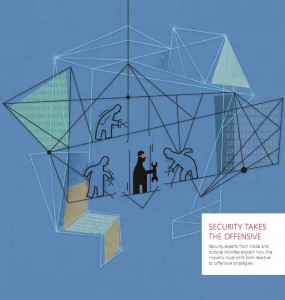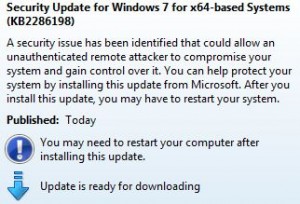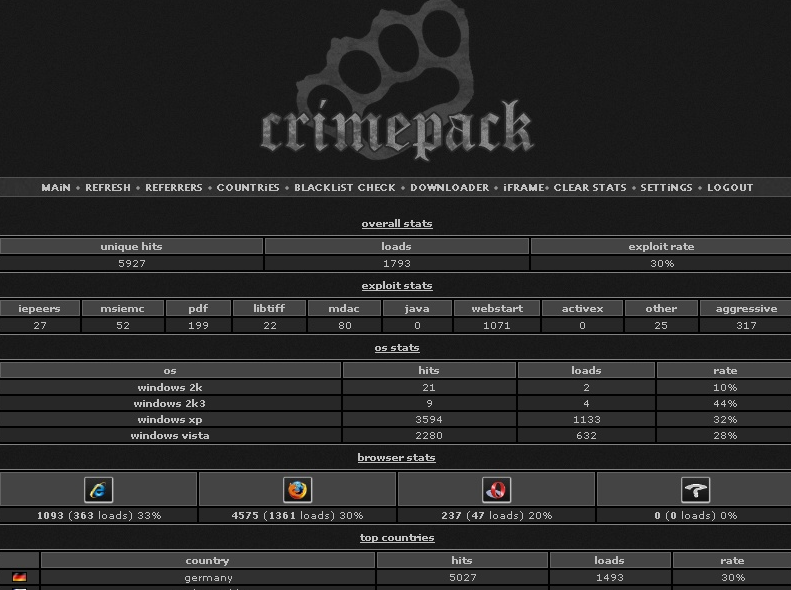 I’ve fallen a bit behind on blog posts about notable security updates (I was counting on August to be the slowest month this year work-wise, but so far it’s actually been the busiest!). Recently, Apple released a series of important patches that I haven’t covered here, so it’s probably easiest to mention them all in one fell swoop.
I’ve fallen a bit behind on blog posts about notable security updates (I was counting on August to be the slowest month this year work-wise, but so far it’s actually been the busiest!). Recently, Apple released a series of important patches that I haven’t covered here, so it’s probably easiest to mention them all in one fell swoop.
NetworkSolutions Sites Hacked By Wicked Widget
Hundreds of thousands of Web sites parked at NetworkSolutions.com have been serving up malicious software thanks to a tainted widget embedded in their pages, a security company warned Saturday.
 Santa Clara, Calif. based Web application security vendor Armorize said it found the mass infection while responding to a complaint by one of its largest customers. Armorize said it traced the problem to the “Small Business Success Index” widget, an application that Network Solutions makes available to site owners through its GrowSmartBusiness.com blog.
Santa Clara, Calif. based Web application security vendor Armorize said it found the mass infection while responding to a complaint by one of its largest customers. Armorize said it traced the problem to the “Small Business Success Index” widget, an application that Network Solutions makes available to site owners through its GrowSmartBusiness.com blog.
Armorize soon discovered that not only was the widget serving up content for those who had downloaded and installed it on their sites, but also it was being served by default on some — if not all — Network Solutions pages that were parked or marked as “under construction.”
Parked domains are registered but contain no owner content. Network Solutions — like many companies that bundle Web site hosting and domain registration services – includes ads and other promotional content on these sites until customers add their own.
Spam King Leo Kuvayev Jailed on Child Sex Charges
A man known as one of the world’s top purveyors of junk e-mail has been imprisoned in Russia for allegedly molesting underage girls from a Moscow orphanage, KrebsOnSecurity.com has learned.
According to multiple sources, Leonid “Leo” Aleksandorovich Kuvayev, 38, is being held in a Russian prison awaiting trial on multiple child molestation charges.
Sources in the United States and Russia said that Kuvayev, who holds dual Russian-American citizenship, was alleged to have molested more than 50 young girls he had lured away from one or more local orphanages. He was brought in for questioning after one of the girls reported the incident to Russian police, who reportedly found videotaped evidence of the incidents.
Brandon A. Montgomery, a spokesman for the Immigration and Customs Enforcement (ICE) division at the U.S. Department of Homeland Security, confirmed that Kuvayev was indicted on Aug. 3, 2009, and arrested on Sept. 15 in Moscow for child molestation charges.
“Our attaché in Moscow is working with the criminal investigative team in Russia, and the investigation is ongoing,” Montgomery said.
The Russian criminal case against Kuvayev, Case. No. 378243, charges him with violations of Russian Criminal Code 134, which prohibits “crimes against sexual inviolability and sexual freedom of the person.” According to sources in Russia familiar with the case but who asked not to be named, Kuvayev is being held in a Moscow jail awaiting trial, which is currently scheduled to start 10 months from the date of his incarceration on Dec. 22, 2009.
Kuvayev is widely considered one of the world’s most notorious spammers. Anti-spam group Spamhaus.org currently features Kuvayev as #2 on its Top 10 worst spammers list.
In 2005, the attorney general of Massachusetts successfully sued Kuvayev for violations of the CAN-SPAM Act, a law that prohibits the sending of e-mail that includes false or misleading information about the origins of the message, among other restrictions. Armed with a massive trove of spam evidence gathered largely by lawyers and security experts at Microsoft Corp., the state showed that Kuvayev’s operation, an affiliate program known as BadCow, was responsible for blasting tens of millions of junk e-mails peddling everything from pirated software to counterfeit pharmaceuticals and porn.
Critical Updates for Windows, Flash Player
![]() Microsoft issued a record number of software updates today, releasing 14 update bundles to plug at least 34 security holes in its Windows operating system and other software. More than a third of flaws earned a “critical” severity rating, Microsoft’s most serious. Separately, Adobe released an update for its Flash Player that fixes a half-dozen security bugs.
Microsoft issued a record number of software updates today, releasing 14 update bundles to plug at least 34 security holes in its Windows operating system and other software. More than a third of flaws earned a “critical” severity rating, Microsoft’s most serious. Separately, Adobe released an update for its Flash Player that fixes a half-dozen security bugs.
Microsoft tries to further emphasize which critical patches should be applied first, and it does this largely by assessing which of the flaws appear to be the easiest and most reliable to attack. According to an analysis posted on the Microsoft Security Response Center blog, the most dangerous of the critical flaws patched this month involve media file format and Office bugs.
Specifically, Microsoft pointed out a critical flaw in Microsoft Silverlight and its .NET Framework, as well as bugs in the Microsoft MPEG-Layer 3 and Cinepak codecs. All of these media format vulnerabilities are critical and could be exploited merely by loading a tainted media file, either locally or via a Web browser, Redmond said.
The software giant also urged customers to quickly deploy a patch that fixes at least four vulnerabilities in Microsoft Office, the most severe of which could lead to users infecting their PCs with malware simply by opening or viewing a specially-crafted e-mail.
Shunning and Stunning Malicious Networks
 McAfee just published the sixth edition of its Security Journal, which includes a lengthy piece I wrote about the pros and cons of taking down Internet service providers and botnets that facilitate cyber criminal activity. The analysis focuses on several historical examples of what I call “shuns” and “stuns,” or taking out rogue networks either by ostracizing them, or by kneecapping their infrastructure in a coordinated surprise attack, respectively.
McAfee just published the sixth edition of its Security Journal, which includes a lengthy piece I wrote about the pros and cons of taking down Internet service providers and botnets that facilitate cyber criminal activity. The analysis focuses on several historical examples of what I call “shuns” and “stuns,” or taking out rogue networks either by ostracizing them, or by kneecapping their infrastructure in a coordinated surprise attack, respectively.
The theme of this edition of the journal is finding ways to take security on the offense, and it includes articles from noted security researchers Joe Stewart and Felix “FX” Lindner.
Here’s the lead-in from my contribution:
The security technologies most of us rely on every day — from anti-virus software to firewalls and intrusion detection devices — are reactive. That is, they are effective usually only after a new threat has been identified and classified. The trouble is that, meanwhile, an indeterminate number of individuals and corporations become victims of these unidentified stalkers.
Until quite recently, this “bag ’em and tag ’em” approach to dealing with malicious activity online had become so ingrained in the security community that most of the thought leaders on security were content merely to catalog the Internet’s worst offenders and abide the most hostile networks. Exponential increases in the volume and sophistication of new threats unleashed during the past few years — coupled with a pervasive attitude that fighting criminal activity online is the principal job of law enforcement — have helped to reinforce this bunker mentality.
Then, in the fall of 2007, something remarkable happened that seemed to shake the security industry out of its torpor: a series of investigative stories in the mainstream and technology press about concentrations of cybercrime activity at a Web hosting conglomerate in St. Petersburg known as the Russian Business Network (RBN) caused the ISPs serving the infamous provider to pull the plug. The RBN, which had been a vortex of malicious activity for years, was forced to close up shop and, subsequently, scattered its operations.
This was the first of many examples that would demonstrate the strategic (and, arguably, cathartic) value of identifying and isolating significant, consistent sources of hostile — if not criminal — activity online. I will focus on two popular methods of taking the fight to the enemy and will offer a few thoughts on the long-term viability of these approaches.
Copies of the journal are available from this link.
Foxit Fix for “Jailbreak” PDF Flaw
 One of the more interesting developments over the past week has been the debut of jailbreakme.com, a Web site that allows Apple customers to jailbreak their devices merely by visiting the site with their iPhone, iPad or iTouch. Researchers soon learned that the page leverages two previously unknown security vulnerabilities in the PDF reader functionality built into Apple’s iOS4.
One of the more interesting developments over the past week has been the debut of jailbreakme.com, a Web site that allows Apple customers to jailbreak their devices merely by visiting the site with their iPhone, iPad or iTouch. Researchers soon learned that the page leverages two previously unknown security vulnerabilities in the PDF reader functionality built into Apple’s iOS4.
Adobe was quick to issue a statement saying that the flaws were in Apple’s software and did not exist in its products. Interestingly, though, this same attack does appear to affect Foxit Reader, a free PDF reader that I often recommend as an alternative to Adobe.
According to an advisory Foxit issued last week, Foxit Reader version 4.1.1.0805 “fixes the crash issue caused by the new iPhone/iPad jailbreak program which can be exploited to inject arbitrary code into a system and execute it there.” If you use Foxit, you grab the update from within the application (“Help,” then “Check for Updates Now”) or from this link.
Obviously, from a security perspective the intriguing aspect of a drive-by type jailbreak is that such an attack could easily be used for more nefarious purposes, such as seeding your iPhone with unwanted software. To be clear, nobody has yet seen any attacks like this, but it’s certainly an area to watch closely. F-Secure has a nice Q&A about the pair of PDF reader flaws that allow this attack, and what they might mean going forward. Apple says it plans to release an update to quash the bugs.
I’m left wondering what to call these sorts of vulnerabilities that quite obviously give users the freedom that jailbreaking their device(s) allows (the ability to run applications that are not approved and vetted by Apple) but that necessarily direct the attention of attackers to very potent vulnerabilities that can be used to target jailbreakers and regular users alike. It’s not quite a “featureability,” which describes an intentional software component that opens up customers to attack even as the vendor insists the feature is a useful, by-design ability rather than a liability.
I came up with a few ideas.
– “Apptack”
– “Jailbait” (I know, I know, but it’s catchy)
– “Freedoom”
Maybe KrebsOnSecurity readers can devise a better term? Sound off in the comments below if you come up with any good ones.
Finally, I should note that while Adobe’s products may not be affected by the above-mentioned flaws, the company said last week that it expects to ship an emergency update on Tuesday to fix at least one critical security hole present in the latest version of Adobe Reader for Windows, Mac and Linux systems.
Adobe said the update will fix a flaw that researcher Charlie Miller revealed (PDF!) at last month’s Black Hat security conference in Las Vegas, but it hinted that the update may also include fixes for other flaws. I’ll have more on those updates when they’re released, which should coincide with one of the largest Microsoft Patch Tuesdays ever: Redmond said last week that it expects to issue at least 14 updates on Tuesday. Update, Aug. 10, 5:06 p.m. ET:Adobe won’t be releasing the Reader update until the week of Aug. 16.
Crimepack: Packed with Hard Lessons
Exploit packs — slick, prepackaged bundles of commercial software that attackers can use to booby-trap hacked Web sites with malicious software — are popular in part because they turn hacking for profit into a point-and-click exercise that even the dullest can master. I’ve focused so much on these kits because they also make it easy to visually communicate key Internet security concepts that otherwise often fall on deaf ears, such as the importance of keeping your software applications up-to-date with the latest security patches.
One of the best-selling exploit packs on the market today is called Crimepack, and it’s a kit that I have mentioned at least twice in previous blog posts. This time, I’ll take a closer look at the “exploit stats” sections of a few working Crimepack installations to get a better sense of which software vulnerabilities are most productive for Crimepack customers.
Check out the following screen shot, taken in mid-June from the administration page of a working Crimepack exploit kit that targeted mostly German-language Web sites. This page shows that almost 1,800 of the nearly 6,000 people who browsed one of the stable of malicious sites maintained by this criminal got hacked. That means some software component that 30 percent of these visitors were running either in their Web browsers or in the underlying Windows operating system was vulnerable to known software flaws that this kit could exploit in order to install malicious software.
Peering closer at the exploit stats, we see that one exploit was particularly successful: Webstart. This refers to a Java vulnerability that Oracle/Sun patched in April 2010, a powerful and widely-deployed software package that many users aren’t even aware they have on their systems, let alone know they need to keep it updated. (By the way, I got some serious flack for recommending that users who have no need for Java uninstall the program completely, but I stand by that advice.) As seen from the chart, this single Java flaw was responsible for nearly 60 percent of the successful attacks on visitors to these hacked sites.
Anti-virus Products Mostly Ignore Windows Security Features
I recently highlighted a study which showed that most of the top software applications failed to take advantage of two major lines of defense built into Microsoft Windows that can help block attacks from hackers and viruses. As it turns out, a majority of anti-virus and security products made for Windows users also forgo these useful security protections.
Patch for Critical Windows Flaw Available
Microsoft today released an emergency security update to fix a critical flaw present in all supported versions of Windows. The patch comes as virus writers are starting to ramp up attacks that leverage the vulnerability.
 There are a couple of things you should know before installing this update. If you took advantage of the “FixIt” tool that Microsoft shipped last month to blunt the threat from this flaw, you should take a moment now to undo that fix. To do that, visit this link, then click the image below the “Disable Workaround” heading, and follow the prompts. You will need to reboot the system before installing the official fix released today, which is available from Windows Update.
There are a couple of things you should know before installing this update. If you took advantage of the “FixIt” tool that Microsoft shipped last month to blunt the threat from this flaw, you should take a moment now to undo that fix. To do that, visit this link, then click the image below the “Disable Workaround” heading, and follow the prompts. You will need to reboot the system before installing the official fix released today, which is available from Windows Update.
The patch issued today carries the Microsoft Knowledge Base (KB) number KB2286198, in case you’ve just run Windows Update and are checking to see whether this update is available to you yet.
You will need to reboot after installing the patch. After I applied this patch and rebooted the system, Windows Explorer stalled, leaving Windows unresponsive. After a forced restart (powering the system off and then on again), my 64-bit Windows 7 system booted into Windows normally.
When this vulnerability was initially disclosed, it was only being used in targeted attacks online. However, as Microsoft warned and others have confirmed, this vulnerability is now showing up in more mainstream attacks. Please take a moment to apply this update today if you can, particularly if your Windows system is not already protected with the FixIt tool mentioned above.
More information on this update is available from the Microsoft bulletin. And as always, please leave a comment below if you experience any problems installing this update.
Texas Firm Blames Bank for $50,000 Cyber Heist
A business telephone equipment company in Texas is trying to force its bank to settle a liability claim over an attack by organized cyber thieves last year that cost the company $50,000.
Attorneys for Dallas-based Hi-Line Supply Inc. recently convinced a state court to require depositions from officials at Community Bank, Inc. of Rockwall, Texas. Hi-Line requested the sworn statements to learn more about what the bank knew in the time surrounding Aug. 20, 2009, when crooks broke into the company’s online bank accounts and transferred roughly $50,000 to four individuals across the country who had no prior business with Hi-Line.
While the contents of that deposition remain closed under a confidentiality order, Hi-Line’s lawyers say the information gleaned in the interviews shows serious security missteps by Community Bank, and that they are ready to sue if the bank does not offer a settlement.
“In the event Community Bank refuses to resolve this matter, now that we have uncovered some of the information obtained by virtue of the court’s order, Hi-Line intends to assert claims for misrepresentation, violations of the Texas Deceptive Trade Practices Act, fraud, and breach of warranties, among other things,” said Michael Lyons, a partner with the Dallas law firm Deans Lyons.
Hi-Line president Gary Evans said the fraud began on Thursday, Aug. 20, about the same time the company processes its normal $25,000 payroll. After Hi-Line submitted that batch of payments to its bank, the unknown intruders attempted two more transfers of nearly identical amounts on Friday and the following Monday, Aug. 24.







